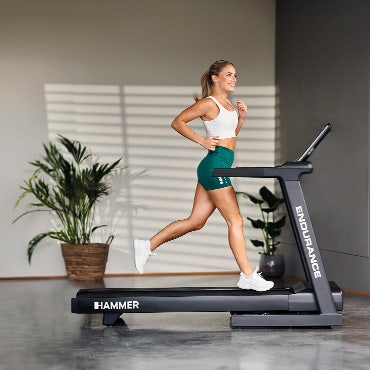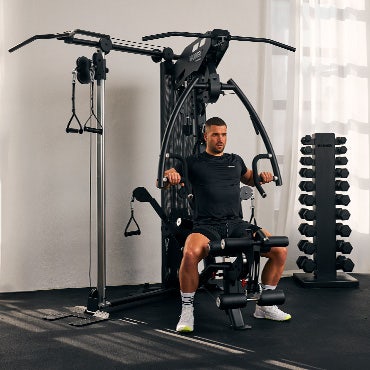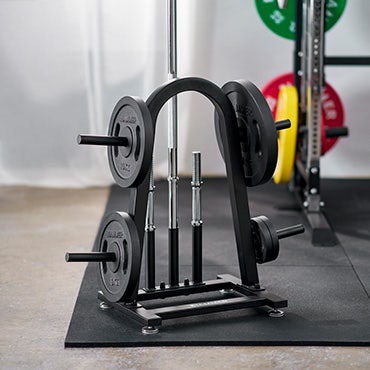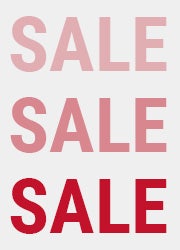Weight plates
Buy weight plates for your strength training
Weight plates are a must for every home gym and are used for with barbells. But also some fitness equipment is loaded with weight plates to intensify the workout. All weight plates in our online shop have a diameter of 30 mm and therefore fit on every standard weight bar. Our chrome weight plates are particularly practical. These are equipped with handles for additional exercises and are available in many weight increments.
When buying weight plates, you should make sure that they are optimally suited to your intended use and that the bore and diameter are compatible with each other and with your . In addition, different materials and coatings make for differences in durability, training feel, feel and look.
What weight should the weight plates I buy have?
With weight plates you can optimally adjust your training weight and combine them as needed. They are available in the following weight units depending on the hole diameter:
- 0.5 kg
- 1.25 kg
- 2.5 kg
- 5 kg
- 7.5 kg
- 10 kg
- 15 kg
- 20 kg
- 25 kg
Your ideal training weight depends on the exercise you choose and your fitness level. In general, weights with which you can do between 6 and 20 repetitions are best for building muscle. Depending on the exercise, you will therefore need a wide range of weight plates to be able to combine the right weight. Furthermore, you should remember to have enough weights so that you can increase in the long term. Otherwise, stagnation will quickly set in and your body will no longer adapt to consistent training stimuli. A set of weight plates such as the is ideal for starting with 30 mm bars and can then be expanded as desired.
Make sure you have at least 2 discs of the same weight unit so that you can load the barbell evenly. When buying weight plates for dumbbells, also note that the weights are distributed over 2 dumbbells and you therefore need more plates in total and 4 plates each for an even load. By combining different discs, fine gradations are possible that allow you to achieve sustainable progress.
What materials and sheaths are available?
When it comes to weight plates, it is not only about the weight and the bore, the surface should also be chosen consciously. Depending on the area of use, different materials have their advantages.
How do I use a cast iron weight plate and what are its advantages and disadvantages?
Cast iron weight plates are particularly durable and virtually indestructible. Cast iron is ideal if you are looking for a rough and natural look. They are available in both diameter and 50 mm . Be sure to buy cast iron plates with the right hole diameter for your bars. Cast iron weight plates are available at particularly low prices, are robust and also come with handles, making them ideal for price-conscious beginners. A disadvantage, however, can be the increased noise level caused by setting down the weights. When exercising, make sure that you use a floor protection mat or a rack to avoid damaging your floor.
Bumper plates vs. cast iron weight plates: What is the difference?
Unlike cast iron weight plates, bumper plates have a wider and softer surface. This makes bumper plates particularly easy on the floor in your training room. Furthermore, bumper plates have a standardised diameter. This can make loading and unloading the dumbbells more difficult. Cast iron weight plates are larger the heavier they are and are therefore more space-saving with small weights, which is especially relevant on a weight plate rack.
Cast iron weight plates are available with different hole diameters, whereas bumper plates are only available for 50 mm barbells and have no handles. Bumper plates are therefore particularly suitable if you have sufficient space and do not need small weight increments, but noise and floor protection are important to you. Heavy weights can be used with both cast iron and bumper plates. Weights of up to 25 kg per plate are common with both families of plates.
What is the advantage of chrome dumbbells?
Chrome dumbbells look especially high quality and bring shine to your home gym! The natural silver dumbbell and barbell bars as well as silver star fasteners are the best visual match for chrome weight plates. To keep their shiny surface for a long time and to reduce the noise level, you should use floor protection mats during training. The weight plates often have rounded corners so that the plates are easy to insert. Chrome-covered weight plates usually have a 30 mm hole for your barbell and dumbbell, weights up to 10 kg per plate and no grip holes. They are therefore very suitable for light to moderate weights and for use on a padded surface.
What are weight plates with PU coating?
Weight plates with coating are very robust and scratch-resistant. The non-slip coating reduces noise during exercise and also allows them to be set down on sensitive surfaces. PU weight plates have handles and are available in all weight units from 1.25 - 25 kg, but only with 50 mm bore. Weight plates with PU coating are therefore ideal if you want to train safely and quietly and have or want to buy an Olympic bar.
Weight plates with rubber surface
Similar to weight plates with PU coating, rubber-coated plates protect the plate itself as well as your floor and other training equipment. This means you train more quietly than with iron plates. Weight plates with rubber coating are available in different weight units for 30 mm and 50 mm bars.
Plastic weight plates
Weight plates with plastic coating often contain sand or concrete in the core. The plastic surface makes them gentle to use, but they are not as robust as cast iron or PU-coated discs. They are therefore mainly suitable for fitness beginners. If you are looking for durable and visually appealing weight plates, chrome, cast iron or PU-coated weight plates are a good choice.
What size is recommended for weight plates?
In addition to the diameter of the weight plate itself, the diameter of the hole is also important. This dimension must be identical for your weight plate and your barbell, otherwise you cannot use them together. Therefore, before buying weight plates and bars, pay attention to the bore specification.
Weight plates 30 mm
Weight plates with a hole diameter of 30 mm are available in weight units up to 10 kg and are used particularly often in the home due to their smaller size. They are often made of iron and coated with rubber or polyurethane to protect surfaces. With chrome dumbbells, such as the , the coating provides a particularly beautiful disc surface.
hole diameter are secured to your 30 mm dumbbell or barbell with a screw or clamp fastener, depending on the barbell.
If you already own weight bars with a 30 mm bar diameter or would like to buy them and also value stylish equipment with a small footprint, 30 mm weight plates are the right choice.
Weight plates 50 mm
Weight plates with a bore of 50 mm are larger overall and usually available in weight units of 1.25 kg - 25 kg. Therefore, these plates are particularly suitable for exercises such as squats or deadlifts, where heavier weights can be handled. Therefore, weight plates with 50 mm bore are also called Olympic plates.
However, are also suitable for beginners due to the fine gradations of the weights and can be combined in any way. In contrast to 30 mm discs, weight plates with a 50 mm diameter are usually only intended for use on , as dumbbells almost exclusively have a 30 mm disc holder.
Therefore, discs with a 30 mm bore fit on dumbbell bars and barbell bars as well as SZ bars with a 30 mm diameter. Weight plates with 50 mm bore fit almost exclusively on barbell bars with 50 mm diameter (so-called Olympic bars), but not on dumbbell bars.
Many 50 mm discs, such as the , also have handles. These are particularly useful if you want to change the weight frequently during a workout or if you want to use several 50 mm plates. Before buying, make sure that you also use a bar with a 50 mm diameter on the disc holders, e.g. the , or order it directly.
Bumper Plates
Bumper plates are a special form of the Olympic 50 mm weight plates. They do not have a standardised disc diameter and only fit on 50 mm disc holders. This means that the distance of the barbell from the floor is always the same, which is indispensable for advanced athletes and competition athletes, e.g. for deadlifting or Olympic weightlifting. Furthermore, bumper plates have a softer surface and even allow the loaded barbell to be dropped without damaging the floor or making a lot of noise.
On the other hand, bumper weight plates do not have grip holes, which can make it difficult to pick up the barbell from the barbell rack. Furthermore, the gradation of the weights is not as fine as with other 50 mm discs, as the standardised diameter of 46 cm does not allow for weights smaller than 2.5 kg. Bumper plates are therefore mainly relevant for advanced and professional users, although the softer surface and lower noise level are also suitable for beginners, especially in the home gym.
If grip and the use of small weight units are decisive criteria for you, go for normal 50 mm discs made of cast iron or polyurethane.
Weight plate stand
If you have many different plates at home, a weight plate stand is also recommended. Here you should also consider the diameter of the hole of your plates and the maximum load capacity. A with a load capacity of up to 160 kg is suitable for 30 mm plates. Weight plates with 50 mm or bumper plates, on the other hand, require a .
Weight plates with handles
Many weight plates made of cast iron or with PU coating have grip holes in the plate. This makes it easier to load your dumbbells and put the plates on the weight plate stand. Especially with heavy weights, this is an important advantage that can make your workout more comfortable and efficient. Due to the increased grip, you can even use the plates individually without a bar like a dumbbell as a training tool. Suitable exercises include
- Bent over rowing
- Front lift
- Push press
- Goblet Squats
- Standing Twists
Especially if you want to change weights more often during a workout, weight plates with handles are useful.
Which closures are available for securing the dumbbells?
To ensure that your workout is not only effective but also safe, you should secure your weight plates on the bar. The type and diameter of your bar should be taken into account.
Clamp fasteners
The simplest form of dumbbell lock is a clamp lock. These are available for both 30 mm and 50 mm bars. The , for example, already includes 2 of them so you can start immediately.
Screw caps
Screw caps can be found on dumbbell bars that have a thread on the disc holder. When buying bars or fasteners, note that screw fasteners need a thread and will not hold otherwise. They therefore need a little longer to be loosened and tightened, but they hold extremely tightly. They are only available for 30 mm rods.
Star-shaped tension locks
This type of lock is suitable for 50 mm rods. A simple lever mechanism allows you to quickly clamp the onto the end of the bar and release it again. This ensures quick weight changes and a strong hold.
Screw caps for Olympic barbell bars
With this 50 mm screw cap you can secure your weights on the Olympic bar. Unlike screw locks for 30 mm dumbbells, these do not require a thread on the bar, but tighten a screw on the lock on the bar. This gives you a particularly firm hold and you can still release the locks quickly.
Where can I test weight plates?
Do you still need help with your decision? Then simply visit us in our HAMMER stores and get expert advice.


Alexander Seifried
Personal Trainer, B. Sc. Nutrition Management and Dietetics, M. Sc. Clinical Sports Therapy and Sports Physiology
















